HUMA Committee Report
If you have any questions or comments regarding the accessibility of this publication, please contact us at accessible@parl.gc.ca.
The Canada Pension Plan (CPP) came into being in 1966 after Parliament passed an Act to Establish a Comprehensive Program of Old Age Pensions and Supplementary Benefits in the spring of 1965. The Act set up a national contributory public insurance program to provide income protection to workers in the event of a long-term interruption of earnings as a result of retirement, disability or death. The first disability benefit was paid in 1970. At present, the Income Security Programs Branch of Human Resources Development Canada (HRDC) administers the plan.10
2.1 CPP(D): What It Is and How It Works
The Canada Pension Plan Disability benefit (CPP(D)),11 the focus of our study and of this report, has the goal of providing a degree of income protection to complement private insurance, personal savings and employment benefit programs by replacing a portion of the earnings of contributors who cannot work because of a disability. Children of CPP(D) beneficiaries up to the age of 18, or up to age 25 if they attend an educational institution full time, can apply for children’s benefits. Other policy goals are: to promote a return to work by some beneficiaries who are able to re-enter the labour force; to be administered fairly and with appropriate accountability; and to remain sustainable for the future.12
The CPP(D) program provides workers with a means to share the financial risks associated with disablement as well as to give them equitable and portable treatment across the country. The universality of the CPP(D) program means that all workers (including those who are self-employed) — no matter the level of risk of injury — have access to benefits that are indexed to inflation if they become disabled. Disability pensions are paid until recovery or death or up to age 65, when they are converted to retirement pensions.
Today, the CPP(D) is the largest single long-term disability income
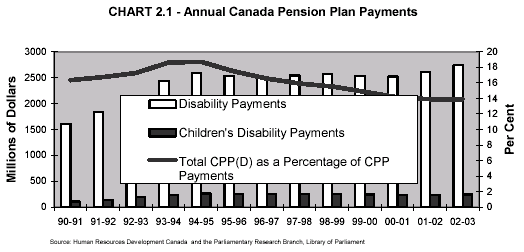
The CPP(D) caseload increased significantly between 1990-1991 and 1995-1996, growing at an average annual rate of 7.8% (Chart 2.2). Thereafter, it began to decline at an average annual rate of 1.2%, falling from 300,118 beneficiaries in 1995-1996 to 282,543 in 2002-2003. Not surprisingly, a similar trend is found for the number of young individuals receiving the flat-rate children’s disability benefit.
The growth in the CPP(D) caseload during the first half of the 1990s is attributed to a number of factors. These include legislative changes in 1987 and 1992 that expanded disability coverage; rising unemployment; and increased referrals of potential clients from social assistance and private insurance carriers.13 Other factors, such as new adjudication guidelines emphasizing the medical basis for approval, stricter eligibility conditions and improved labour market conditions, are thought to be key contributors to the declining caseload in the late 1990s and early 2000s.
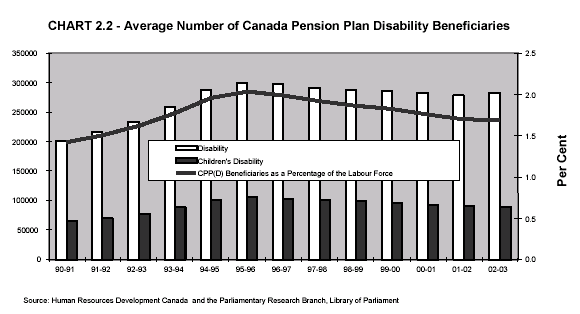
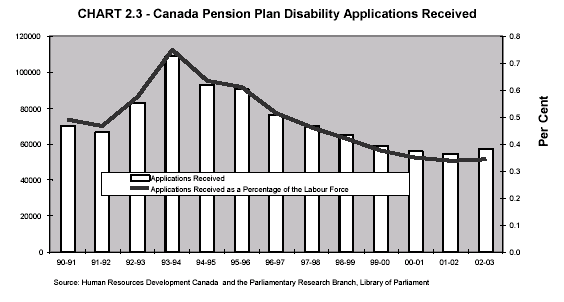
The number of CPP(D) applications declined steadily after 1993-1994 (Chart 2.3). The volume of applications for CPP(D) relative to the size of the labour force is lower today than at the beginning of the 1990s. The relative size of today’s CPP(D) caseload, however, has increased. Despite the reduction in the CPP(D) caseload during the last five fiscal years, the number of CPP(D) beneficiaries in 2002-2003 — expressed as a percentage of the labour force in 2002 — was more than 20% higher than at the beginning of the last decade. Moreover, the total number of CPP(D) beneficiaries (including children) expressed as a proportion of the total population also increased during this period by a similar amount.
In 1990, women accounted for 31.6% of the total CPP(D) caseload. By 2002, their share of the total caseload was 48.3%, an increase of more than 50% (Chart 2.4). During the Subcommittee’s roundtable on 21 May 2002, labour force growth among women was cited as an obvious explanation for the rapid growth in women’s share of the CPP(D) caseload. While this is undoubtedly an important factor, we note that women’s share of employment growth during this period was about 58%, well below their more than 85% share of growth in the CPP(D) caseload in the same period.
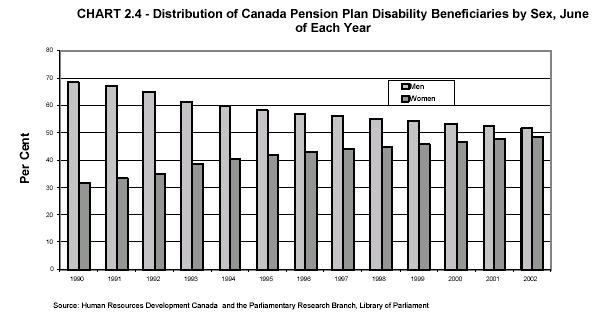
In order to introduce the Canada Pension Plan in 1966, the federal government had to negotiate an amendment to the British North America Act (now the Constitution Act, 1867).14 This allowed the federal government to put a wider range of benefits within the CPP. It also allowed the provinces the choice of setting up a comparable plan. To date, only Quebec has done this and has put in place the Quebec Pension Plan (QPP), a parallel but independent program.
Since its introduction, therefore, federal/provincial considerations have determined, and continue to determine, the nature of changes to the CPP as a whole, as well as to the disability benefit. The Act requires that any major changes proposed by the federal government must be approved by two-thirds of the provinces included in the CPP or a comparable plan, and with two-thirds of Canada’s population. Even though Quebec has its own plan, it also has a say in determining changes to the CPP. The provinces must approve amendments dealing with the type and level of benefits, as well as contribution rates, management of the CPP account and the CPP Investment Fund (established in 1998). Both levels of government get actuarial information about the functioning of the CPP from the Office of the Superintendent of Financial Institutions. The Office’s Chief Actuary is responsible for conducting an assessment at least once every three years or whenever legislation regarding the plan is introduced. This information is used during a federal/provincial review of CPP that takes place every three years. Changes or amendments to either the disability or retirement provisions of the plan follow these reviews. Such a review began during the fall of 2002.
Many commentators, particularly Michael Prince of the University of Victoria, who also appeared before the Subcommittee, have highlighted the problems with the CPP(D) that have resulted from the low profile of the program compared to the retirement benefits portion of the CPP. Prince has pointed out that compared to recipients of Old Age Security benefits, retirement pensions or veterans’ pensions, the CPP(D)’s beneficiaries are not seen as an important political constituency. He has concluded that in government reviews, reports and academic literature on public pension policy, the CPP(D) has not received great attention.15
Given the fragmentation of the disability income system, one of the issues that remains unresolved is whether the CPP(D) should remain tied to the retirement component of the CPP. If not, what alternatives exist? CPP(D) is very much the smaller part of the CPP benefits system. In 2002-2003, it accounted for about 13.9% of all CPP benefits paid out by the plan. Decisions about policies and programs for the CPP(D) have been, to a large extent, driven by the need to preserve the security of the CPP’s retirement benefits.16
Although the CPP(D) has changed since its introduction, the context of the Subcommittee’s study has been most affected by the changes introduced since 1994. Starting that year, CPP(D) went through a period of retrenchment prompted by a two-year series of governmental reviews, federal/provincial reviews and a ministerial task force that undertook public consultations.17 The result of this process, the last set of major changes reflecting the decision to reduce costs by reducing the level of benefits and restricting eligibility, was enacted in 1998 by Parliament as Bill C-2, The Canada Pension Plan Investment Board Act. A chronology of recent major changes to the CPP is presented in the following tables.18
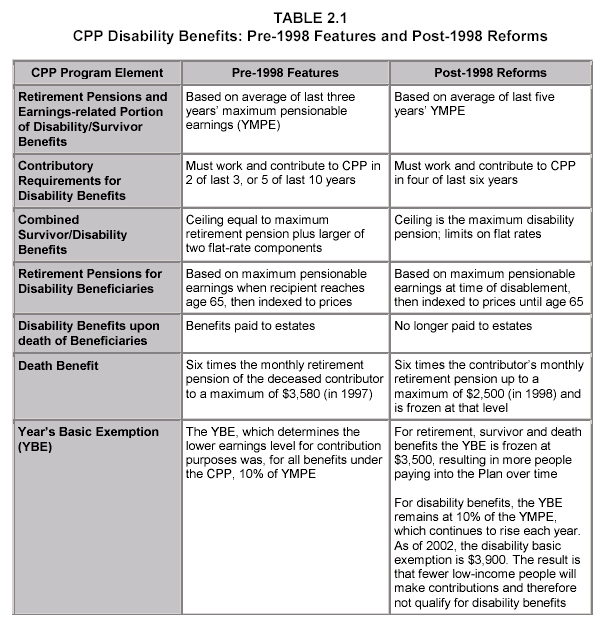
During the same period, CPP(D) went through a series of other changes either as the result of administrative decisions or rulings by the Courts. These are outlined in Table 2.2.
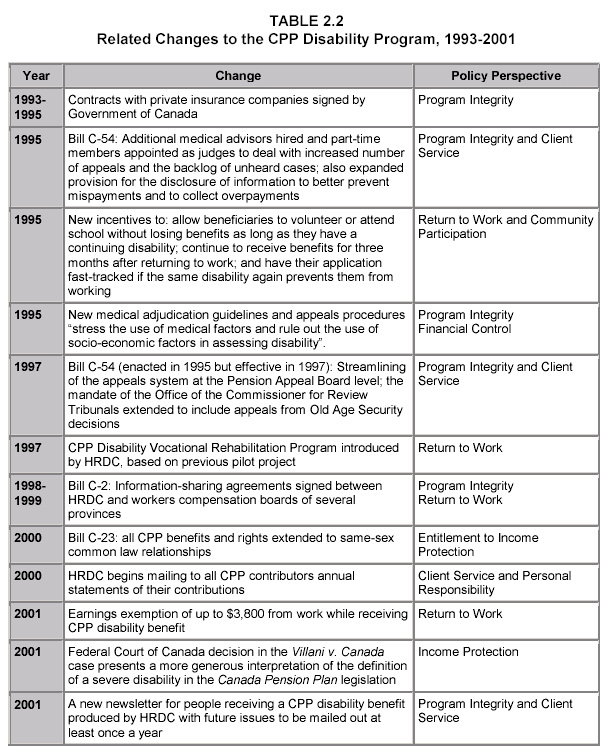
2.2.1 How Relevant is the CPP(D) Program to Canadians?
It’s all about values. Since we needed to know how Canadians viewed the Canada Pension Plan Disability program we asked whether or not they valued its existence and whether it embodied the principles that they believed it should. We asked issue poll respondents three questions to determine the relevance of the CPP(D) program to Canadians. Results revealed that a majority of respondents (80%) strongly agreed that it is important to have a public insurance program to provide income support to people with disabilities who can no longer work. As well, a vast majority of respondents (91%) either agreed or strongly agreed that it is important to them that we have a public disability insurance program based on the principles of universality, portability, user contributions, and partial wage replacement.
2.2.2 Is CPP(D) Meeting its Objectives and Principles?
On the other hand, when asked whether the Canada Pension Plan Disability program currently meets its objectives and principles, respondents were divided. Overall, 41% of respondents either disagreed or strongly disagreed that the CPP(D) program currently meets its objectives and principles, whereas 36% either agreed or strongly agreed and 23% neither agreed nor disagreed.
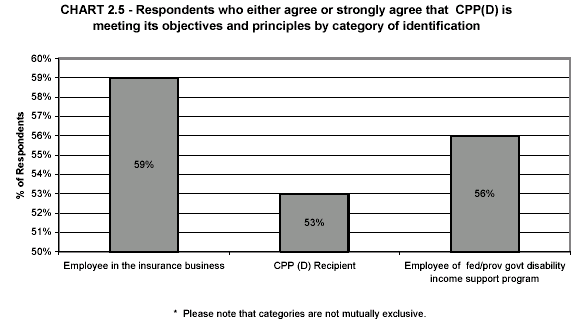
The majority of respondents who identified themselves as CPP(D) applicants or appellants and/or as legal representatives of persons with disabilities do not think that the CPP(D) program currently meets its objectives and principles. At the other end of the scale, a majority of respondents who identified themselves as CPP(D) recipients, employees of a federal/provincial government disability income support program, and/or employees in the insurance business indicated that they think CPP(D) is meeting its objectives and principles (Charts 2.5 and 2.6).
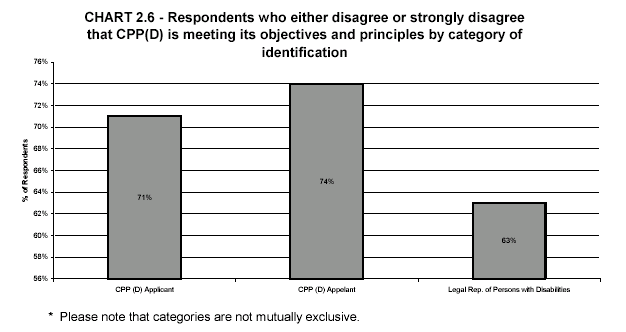
These results are not surprising since it is natural that those who are going through the most difficult part of the process such as applying for, or appealing, a decision about CPP(D) benefits would most likely see the program in a more negative light. They are joined in this view with those who represent persons with disabilities and defend their rights at times of conflict. Their dealings with the CPP(D) program occurred at stages of the process when people have to substantiate their disability according to stringent guidelines, subject to interpretation by CPP(D) staff. On the other hand, those respondents whose applications have been accepted, those working in the insurance business and those who work for a government disability income support program are more likely to appreciate the positive aspects of the program.
CPP, as it is crafted today, is not meeting the legitimate needs of all those who should qualify: by virtue of their contributions and their disability. There are groups of people who have made significant contributions to CPP, and who have severe disabling conditions that prevent them from working, who cannot qualify for the disability benefit. The CPP program is failing these people. (BC Coalition of People with Disabilities, E-Consultation Participant)
One of the main problems with the system is that disability benefits are based on the capacity of a person to work. This policy was developed in the 1960s in a social context that did not consider disabled people as active members of the population. With the recent technological breakthroughs and medical progress in the treatment of diseases and injuries, disabled people are increasingly active in society. (Elisabeth Ostiguy, Director of Public Issues, Canadian Mental Health Association)19
Certain things weren’t discussed at all [during the CPP review] in 1996, the questions of new diseases, episodic diseases and the greater flexibility you have to build into the disability program to take into account these changes. (David Walker, former Parliamentary Secretary to the Minister of Finance)20
The study undertaken by the Subcommittee looks at many of the 1998 changes to CPP(D) in light of the circumstances of 2003. In terms of general conclusions, our witnesses — those who appeared in person and those who sent us their views in the e-consultation — agreed. The Subcommittee endorses their views.
The underlying principles of CPP(D) still reflect the values of Canadians.
The CPP disability is an important program. It was a significant achievement of Canadians and the federal-provincial governments in the 1960s. It’s worth keeping and doing so within the Canada Pension Plan. It needs some internal reforms, but perhaps even more importantly, it needs to be reinforced with other major changes. (Professor Michael Prince, University of Victoria)21
The legislation, practices and administration of the program have not kept up with the times. As an aside, we would note that this shows up particularly in the French-language version of the Act. It uses terminology regarding disability that reflects the attitudes of forty years ago. Obviously, this language is also reflected in administrative manuals and materials. It is hard for us not to believe that it affects the approach of those who administer CPP(D) if they are dealing in an environment that uses archaic language unsuited to today’s circumstances.22
The CPP(D) program must reflect human as well as fiscal realities. The Subcommittee shares the view of Sherri Torjman who told us that:
I’m somewhat concerned about the fact that something might come out of the process at the end of the day that does not ensure Canadians are better off. Fiscal responsibility or the fiscal lens is absolutely crucial in anything we do. But it is only one lens. The human lens is extremely important. Personally, I go into a review with that lens. (Sherri Torjman, Vice-President, Caledon Institute of Social Policy)23
The “human lens” will be ineffective without a flexible approach. Universally, everyone argued that CPP(D) must be flexible in order to serve Canadians, both those with disabilities and those without.
Policy needs to be flexible. (Ainsley Chapman, Canadian Aids Society)24
[W]e start our brief by emphasizing the importance of supporting and strengthening a public plan that is portable and flexible. We believe the program does need to be strengthened, so that it is a real and continuing part of the social safety network. (Harry Beatty, Canada Pension Plan Working Group of Ontario) 25
We really need to have a program that is far more flexible and far more able to meet a whole range of needs. (Sherri Torjman, Vice-President, Caledon Institute of Social Policy)26
As a rehabilitation counsellor here are the main issues I see emerging from issues presented by clients: …
— our systems (legal & financial) are focused too much on "permanent disability" which puts too much emphasis on having an individual prove how unable they are, versus finding flexibility to focus on their abilities and adaptations… (Anonymous, E-Consultation Participant)27.
There must be ongoing monitoring and information for true flexibility to be achieved. Obviously, there is a need for systematic research to help bridge the gap between values and practice in the functioning of the CPP(D).
Sometimes you know exactly what you’re doing and sometimes you’re not sure what the impact is going to be. Then two or three years later it may be positive or it may be negative, but you need to hear voices from the communities. … to hear back what these impacts have been. (David Walker, former Parliamentary Secretary to the Minister of Finance)28
Recommendation 2.1
The Committee recommends that the current Federal/Provincial/Territorial Review of the Canada Pension Plan Disability take into account the fact that the current operations of the plan do not fully reflect the values that underlie the current legislation and regulations. One of these relates to equal access and we recommend that the Year’s Basic Exemption (YBE) for the purposes of disability be returned to $3,500 the same as that for retirement benefits.
Recommendation 2.2
The Committee recommends that the Government of Canada establish a permanent joint government and stakeholder advisory group (the CPP Disability advisory committee) with an ongoing mandate and resources to monitor and appraise the performance of the CPP disability program to ensure that it meets its stated purpose and objectives. Representation on the advisory group should include federal officials (Human Resources Development and Finance), health care providers, various disability organizations, patient advocacy groups, return to work and rehabilitation professionals. This advisory group should review performance and recommend changes to the CPP(D) on an ongoing basis and as part of the three-year federal/provincial/territorial review. The advisory committee should submit an annual report on its activities to the Standing Committee on Human Resources Development and the Status of Persons with Disabilities.
Recommendation 2.3
So that future policy decisions pertaining to CPP(D) will be based on higher quality information, the Committee recommends that the Government of Canada make improvements to the analytical base of information about CPP(D) by encouraging research and establishing:
| a. | partnerships between Human Resources Development Canada and the Social Sciences and Humanities Research Council of Canada; |
| b. | financial support for academic research on disability income and supports to improve quality of life for Canadians with disabilities; |
| c. | fellowships to lever money for research on the disability income system; and |
| d. | public sources of data pertaining to the operations of the federal disability income system, at Statistics Canada data centers across Canada. |
| 10 | For a thorough history of the CPP’s policy development and program administration, see Sherri Torjman, The Canada Pension Plan Disability Benefit, Caledon Institute of Social Policy, Ottawa, 2002. |
| 11 | It should be noted that Quebec administers its own disability insurance program in a similar manner, under the Quebec Pension Plan. |
| 12 | For a policy history of the CPP program see: Michael Prince, Wrestling With the Poor Cousin: Canada Pension Plan Disability Policy and Practice, 1964-2001, paper prepared for the Office of the Commissioner of Review Tribunals Canada Pension Plan/Old Age Security Government of Canada, available online at http://ocrt-bctr.gc.ca/pubs/prince/index_e.html. |
| 13 | Canada Pension Plan, Annual Report of the Canada Pension Plan, 1996-97, Ottawa, 1997, p. 31. |
| 14 | This section itself was an amendment added to the Constitution Act in 1951 to allow the federal government to enact laws related to old age pensions as long as the legislation did not affect provincial legislation. |
| 15 | For a policy history of the CPP program see: Michael Prince, Wrestling With the Poor Cousin: Canada Pension Plan Disability Policy and Practice, 1964-2001, Ottawa, 2002. This paper was prepared for the Office of the Commissioner of Review Tribunals Canada Pension Plan/Old Age Security Government of Canada, available online at http://ocrt-bctr.gc.ca/pubs/prince/index_e.html. |
| 16 | Finance Canada, The Canada Pension Plan: Securing its Future for All Canadians, Ottawa, 1997, p. 19. |
| 17 | The report on the public consultations noted that disability benefits had provoked considerable public debate because some people were concerned about the rapid escalation of CPP(D) costs while others wanted a new disability income benefit. Many believed the cost of disability benefits was threatening retirement benefits and should, therefore, be reduced. (Finance Canada, Report on the Canada Pension Plan Consultations, Ottawa, 1996 see also http://www.cpp-rpc.gc.ca.) |
| 18 | Michael Prince prepared these tables for his paper entitled Wrestling with the Poor Cousin (see Charts 13 and 14). |
| 19 | Subcommittee on the Status of Persons with Disabilities (hereafter SCSPD), Evidence (9:15), Meeting No. 7, 20 February 2003. |
| 20 | SCSPD, Evidence (10:40), Meeting No. 23, 21 May 2002. |
| 21 | SCSPD, Evidence (16:20), Meeting No. 5, 5 February 2003. |
| 22 | In French, section 42 states that: |
| 23 | SCSPD, Evidence (10:05), Meeting No. 23, 21 May 2002. |
| 24 | SCSPD, Evidence (9:05), Meeting No. 7, 20 February 2003. |
| 25 | SCSPD, Evidence (16:25), Meeting No. 6, 12 February 2003. |
| 26 | SCSPD, Evidence (15:55), Meeting No. 5, 5 Feb 2003. |
| 27 | Stories where participants indicated that they only wish to share their experience with the Subcommittee have been quoted in this report as “anonymous” with the inclusion of their province of residence. It should be noted that participants who chose not to register on the e-consultation Web site but participated in the process by sharing their stories are also quoted as “anonymous” but in those cases, there is no indication as to their province of residence. |
| 28 | SCSPD, Evidence (10:40), Meeting No. 23, 21 May 2002. |